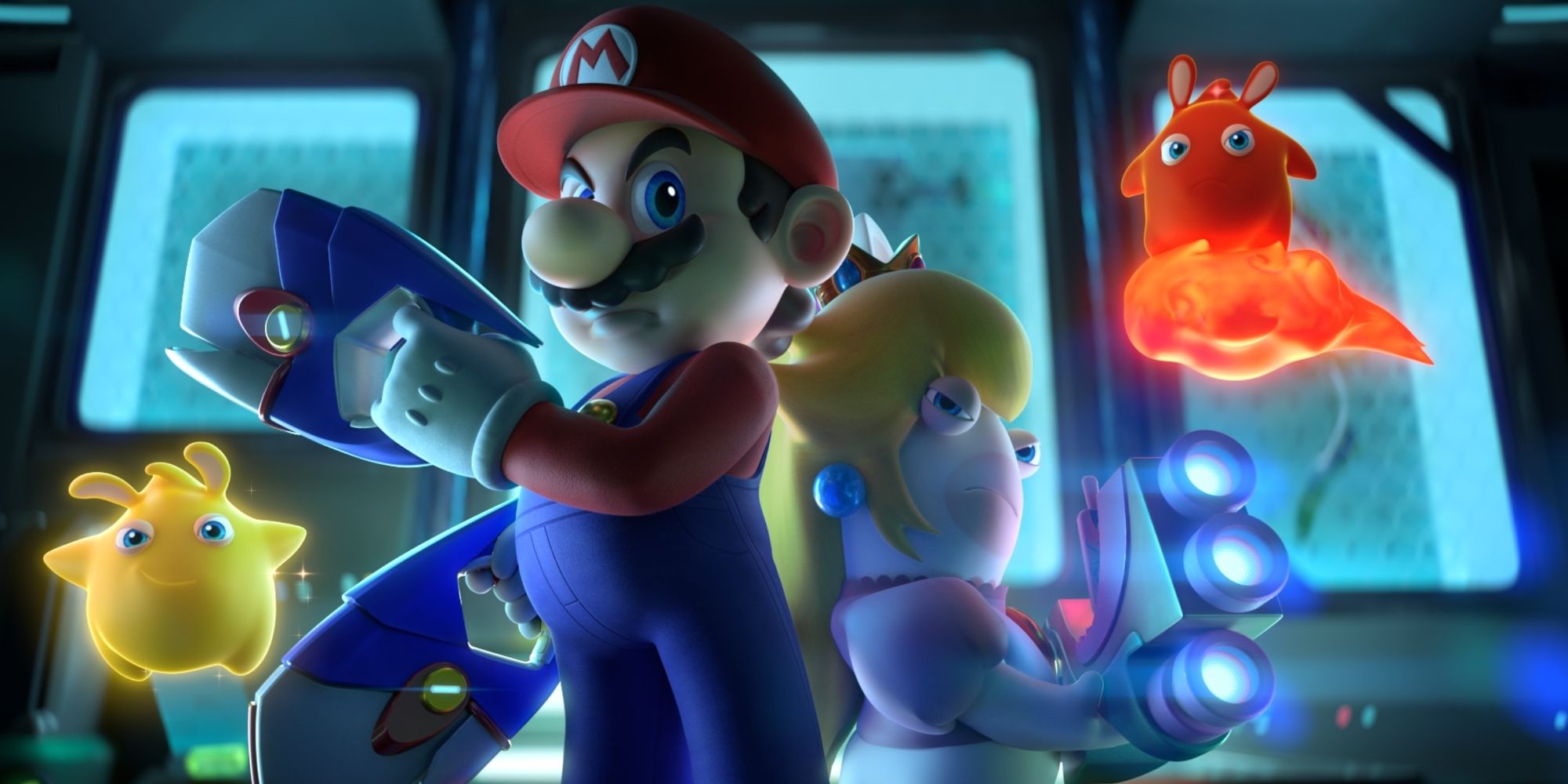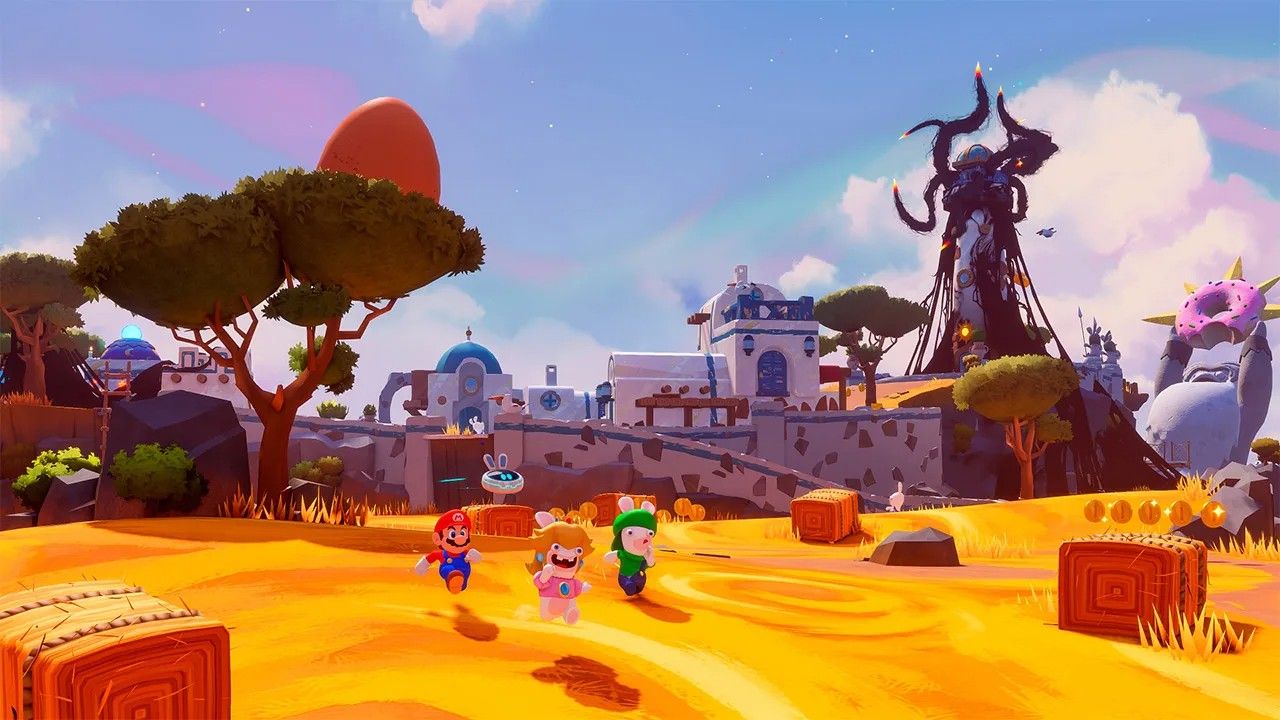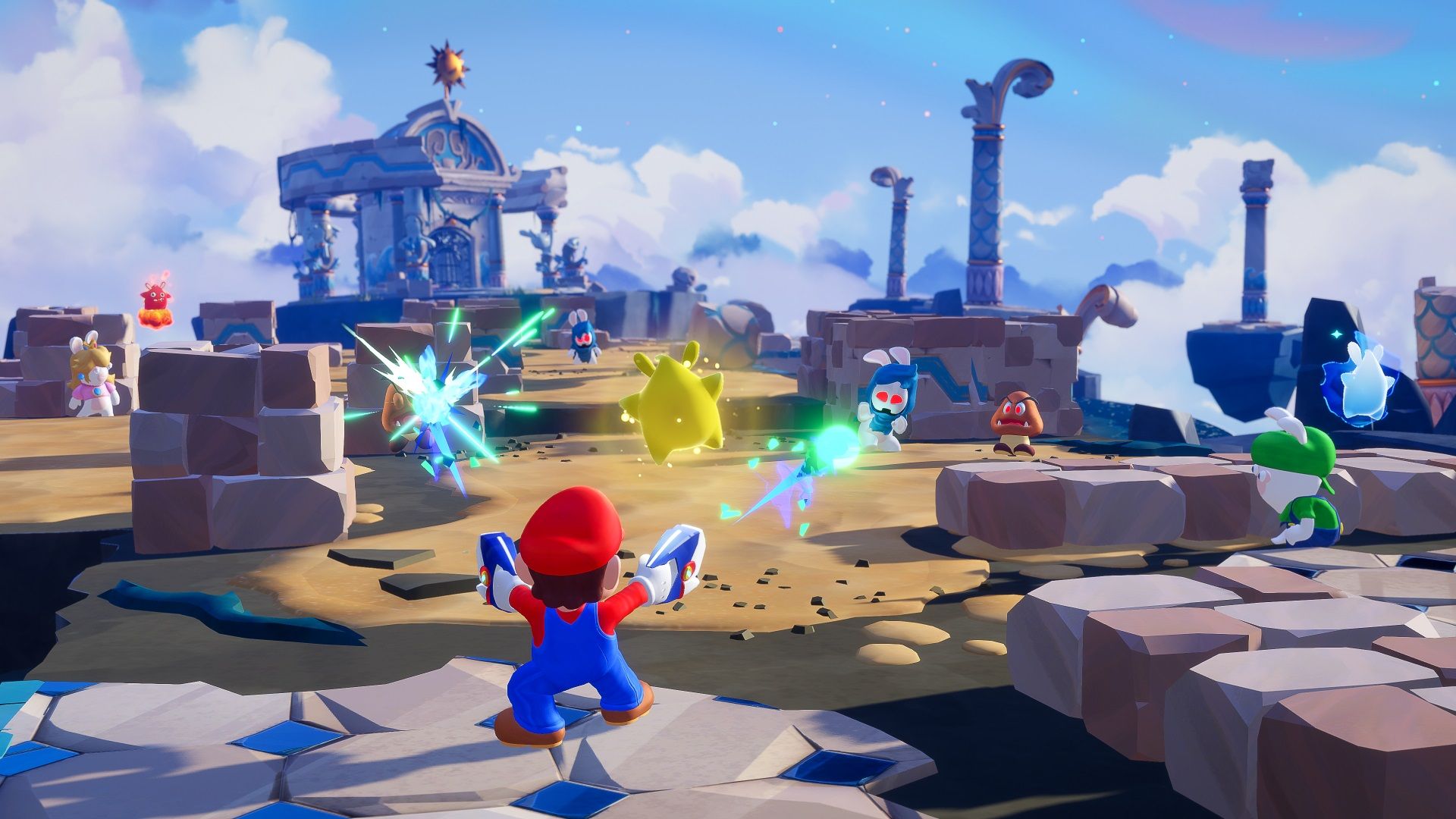Mario + Rabbids Sparks of Hope is taking the series to the stars, as Mario and the Rabbids team up to face cosmic horror that is threatening planets around the universe. The original Mario + Rabbids Kingdom Battle was a turn-based strategy game with levels that had straight lines from battle to battle, with some backtracking that involved puzzles. Sparks of Hope is taking a new approach, with a more real-time approach to combat and actual levels that players can explore, take on sidequests, and find hidden secrets.
The gameplay in Sparks of Hope is adding a lot of new elements that weren't present in the original game. The character roster now includes Bowser, Rabbid Rosalina, and Edge, who is a brand new Rabbid fighter that isn't connected to the Super Mario Bros. series. Players can now use items in battle, but these take up actions that can otherwise be used to attack. The Sparks are the biggest addition to the game, as these are Rabbified versions of the Luma from Super Mario Galaxy, and equipping them grants passive buffs, as well as special attacks that can be unleashed in battle.
Sparks of Hope is launching on Nintendo Switch on October 20, which means fans won't have long to wait to play the game. Screen Rant recently attended a hands-on preview event for Mario + Rabbids Sparks of Hope and had a chance to interview producer Xavier Manzanares about the game. He discussed the Ray-Man content in the upcoming Season Pass, the expectations following the Donkey Kong Adventure DLC, and the change to a more real-time approach from what was in the original game.
Sparks of Hope definitely has a darker tone compared to the first game, especially with the enemies, even though it's still quite comedic. What prompted this change in direction?
Xavier Manzanares: We wanted to expand the Mario + Rabbids universe, we put in place the Kingdom Battle games, so as soon as we saw Beep-0 and all those elements that were technology-based, we said "Hey, what about science fiction" or things around galactic elements. So, we went in space and then we decided to have planets, a galaxy, an enemy that is threatening whole galaxies and it went on and on. So, this galaxy theme was really at the base of everything we decided to create, including the enemies.
Sparks of Hope has introduced items as a mechanic alongside the Sparks, letting players use things like Super Mushrooms to heal and POW Blocks to perform AOE attacks. This gives characters a much greater variety of actions and it's a big gameplay shift from the archetypes from the first game. What design problems did that present, because just the ability to heal themselves is a big shift in what the characters do in the first game.
Xavier Manzanares: So, the way we started to work on the battle system, was to put in as much as possible, elements that would be interesting for combos and tactics. So, we have the archetypes that we revamped from the first game. But the archetypes were already important. The skill tree that added specificities that depended on how you play them, how you want to play it. But then, we added the items that can lead to, for example, healing. If you have the healer in your team, but you have to shift in the way you use your own tactics because an item is taking an action when you do your turn. But then, there was also about the Sparks that added their own bonuses, because you have an active bonus, a passive bonus. So I would say, in the past even had more but it was too much, it was becoming chaotic. So, now we're pretty happy with what we have, but it took two years and a half or three years just to do balancing and tune those elements, so that we don't have a situation where players are just running too quick in a direction and it being chaos, when they want to use tactics. So, it's a lot of work to balance all those elements.
So the Team Jump action now lets characters float for a bit, instead of landing directly, which allows the player to guide the movement, but it doesn't tell you exactly where they land. Why was this change made?
Xavier Manzanares: It's part of the real-time aspect that we wanted to add. Of course, we wanted to keep the precision of going in cover, hitting an enemy, these were really important, so even if we added action, we wanted it to avoid destroying that part, we needed to keep it. But when it comes down to the Team Jump, the way we really did it is because we thought it was this real-time action bet that you have to do, by learning the curve of your character, because depending on what you did in the skill tree, you can go further, so it's about the players' learning the ropes and the details of what you do. So, this real-time aspect to us was fun, even though at first you have to guess and then learn how it works.
Mario + Rabbids Kingdom Battle had Co-Op and PVP modes. Will they be appearing in Sparks of Hope?
Xavier Manzanares: No. We decided in the middle of production to focus on the solo experience. Because, actually as we brought many things from the original concept, we started to see how many elements it brought to the table, and to balance that, this revamped system, we wanted to focus our attention on the solo aspect. So, it was really important for us and we decided to assume that the decision, in order to scope out dangers, where we could go many directions, but then it's unbalanced everywhere and it's a game that never ships. So, it was a decision we took during production.
Was there any feedback that the team received from Mario + Rabbids Kingdom Battle from players that influenced any of the design choices in the sequel?
Xavier Manzanares. It's true that when we did the first game, we had no expectations, nobody knew about what we were doing, so we were taking decisions based on what we liked as a team. For Sparks of Hope, because of Donkey Kong: Adventure but also Mario + Rabbids Kingdom Battle, we started to see a lot of feedback, things we decided to do, like for instance, we received a lot of feedback on the exploration. People loved the Donkey Kong Adventure environments, they wanted to visit, and discover even more, but it was blocked by what we decided to put in place in terms of navigation. So, that was when we decided to say "Hey, maybe we should open up, you know it could be interesting". But the danger was to open up in a way where players would get lost and maybe not have a good rhythm between combat and exploration. So we took a lot of time to get this balance and rhythm between exploration and combat. But yeah, this is an example of listening directly to what people were saying within the community.
Was any thought given to letting players reverse an action, similar to the later Fire Emblem games, where you can go back a turn, reverse a movement, in case of a mistake?
Xavier Manzanares: We considered many things. Even at first we still had the route system and the cursor for instance and of course this direction could have been a choice. Within that option we tested things like reverse and fast forward, etc, things like that, but we decided to go the route of... let's say, action directing the action. So, we didn't put it in the game anymore, because now it's all about real-time and things you can do, so for instance, you can dash a bomb, take the bomb, it can explode in your hands, so you have to watch out. It's all real-time, and this was the direction we decided to take.
What was it like working with Nintendo with such iconic characters? What kind of process was there for approving some of the, shall we say, "Un-Mario-like" humor. I'm thinking of things from the first game, where Princess Peach punts the Snow Rabbid. Things like that.
Xavier Manzanares: So, it's sort of the Mario+Rabbids series let's say, now that we have a few games, is all about this fusion between the two universes. And with the Rabbids we have the perfect excuse to test things up compared to what we've seen in other Mario games for instance with Mario. This is what is expected now from players but also from Nintendo and the relationship we have with them. Basically, what they told us in the past and they said many times "It's your game guys, it's your vision and go where you wanna go, but we will validate things like Mario, how he behaves, to make sure that it's on par with the expectation from the players, but besides that, it's your vision". So, when it comes down to humor, yeah, we had many ideas of things that we could do between the Rabbids and Mario and friends, or even the way they act, and now that we gained even more trust from Nintendo, it's been eight years now, we added for instance, Bowser. And Bowser being in the game with Mario, in a main Mario game, like an adventure game, is something very tricky, because he needs to fit, and this is based on trust and we managed to get this.
By the same token, how much freedom were you allowed when selecting elements of the Mario games to use in this game? For example, combining elements with Rabbids, for example, Rabbid Rosalina?
Xavier Manzanares: Well, as they also want to be surprised and see what our vision is. It's really free at first, but the only rule is that it needs to fit the universe or it needs to have a link with the tactics, it needs to bring something to the gameplay. If it's just adding something because it's cool or it's coming from another game we like: it doesn't work like that. It needs to be really linked to what we're doing, in terms of vision, in terms of package. So, as long as we have a logic behind the choice, then Nintendo is pretty much open to many many things.
How have the gameplay elements from the Donkey Kong Adventure DLC from the first game been integrated into the sequel, as this was a very well-received DLC?
Xavier Manzanares: We introduced a lot, it's true. The Donkey Kong Adventure DLC was all about action and freedom of movement, you could take your hero and throw it; you could go from the beginning of the map to the end of the map very quickly. So, that's when we decided to say "Hey, maybe a focus on action and then real-time elements can be very interesting" because we've received a lot of positive feedback from that. It was breaking the mold that we set in Mario + Rabbids Kingdom Battle and it was nice, so we decided to go that way, thanks to the DLC for Sparks of Hope.
Will the Honey status effect and similar effects like Ink and Freeze be returning in Sparks of Hope? They worked really well with the teamwork mechanics in the first game, where you could free your allies by jumping on them.
Xavier Manzanares: Yeah. So, we still wanted to have this mix of things you could do and interaction. So, we have super effects and elements and depending if it's something that is a defense move or an attack move, depending on where you jump, you can do a Team Jump, you can remove some elements. Also, if you dash an enemy that is already on fire and is weak to fire, you dash it with water, it can interact. So, we still have those connections between the elements. Of course, then we worked a lot on the interaction between techniques of some heroes, versus what you could do with improving Sparks. So, for instance, having a Spark really adds a lot elements and damage to your dash, could be interesting, but you expose your hero to be very close to the enemies on the next turn, so if you have a technique, like Peach's technique that is shielding you, it can be interesting, because it means that you're reducing the risk of having an issue with your hero after dashing all of the enemies in front. So, making those choices, and as you can equip two Sparks per hero, is huge, because depending on that, it changes a lot of the options that you have been offered, and then it could be a mistake as well, so you have to think ahead. That's why at the beginning of the battle you can choose to change that, when you see the battle itself you say "Hey, maybe we need to switch, we need to change our strategy". So that's the way we went for it in Sparks of Hope.
Ubisoft recently announced that Sparks of Hope will receive crossover DLC with Ray-Man. Will this be a separate episode like the Donkey Kong Adventure DLC, or will it be somehow integrated into the main story?
Xavier Manzanares: So, it's a separate episode, because we wanted to have complete freedom with what we wanted to do. So, we're working on three DLCs right now... starting. We're finishing the game and starting parallel to working on the DLCs. Then, for example, for Ray-Man, which we just announced: separate adventure, separate planet. So, yeah it's gonna be cool, a lot of options.
The Season Pass for Sparks of Hope has been announced on the official website it has three episodes. What kind of forms will these DLC episodes take and are there any more crossovers planned in the future?
Xavier Manzanares: So, we have three DLCs. The first one will all be about a new game mode, it's quite exciting, we don't want to reveal too much or spoil too much, but we will reveal it soon. The second one and the third one are new adventure and new planet, and the third one we talked about will be about Ray-Man. In the past, with Donkey Kong Adventure, the bar was set quite high in terms of expectations now from the players. So, we don't want to deceive, we don't want to be under what we released in the past in terms of quality, in terms of differentiation, and creativity. So that's where we set the bar with the three DLCs in Sparks of Hope.
Mario + Rabbids: Sparks of Hope will be released for Nintendo Switch on October 20, 2022.



